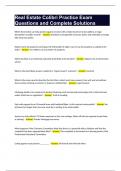Notes de cours
BIOLOGICAL AND COGNITIVE PSYCHOLOGY: all lecture notes summarized (including pictures and examples)
- Cours
- Établissement
- Book
This document contains all lecture notes for the course: BIOLOGICAL AND COGNITIVE PSYCHOLOGY. I listened to all the lectures one by one and transcribed them in full detail (including images and examples for clarification). This really contains everything you need to know for the exam! *With my ...
[Montrer plus]













